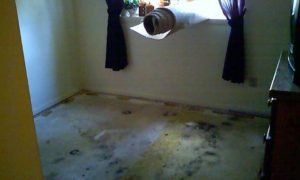Mold Under Carpet and Capet Pad On Concrete
Mold under your carpet and on concrete can cause serious damages to your health and property.
Why Mold Is Dangerous/Toxic
Mold is hazardous in various ways, but mostly because it produces and disperses mycotoxins into the atmosphere. They are produced in varying degrees depending on the species of mold that is present. For example, black mold generally produces and releases much more mycotoxins than white mold does.
Here are some common effects that people may experience as a result of being around mold:
- Allergic reactions
- Memory loss or foggy memory
- Trouble focusing
- Fatigue
If you are experiencing any of these symptoms, especially right after your property has suffered from water damage, you may have mold growing in your property. We recommend testing your building with a mold testing kit and calling the number on our website for a free estimate from a local professional.
How Common Is Mold in Buildings?
Mold is actually quite common. While wet climates are generally at higher risk for mold growth, it can be found almost anywhere in the world.
What Mold Needs to Grow
The two factors that mold needs for growth is a moisture and a food source, like wet wood. It particularly does well in places where the temperatures are around 68°F, there’s low lighting, and there’s poor air circulation. If the moisture has risen in your building for some reason, it is quite possible that there is mold present. You should try to make sure that you can keep moisture controlled to avoid mold growth.

The Speed at Which Mold Can Grow On Carpet
This will vary based off of many different factors, but in general mold can grow within 24-48 hours. That is why it is important to act fast if you have any water damage issues in your home.
Mold Under Carpet and on Concrete Professional Remediation Process
Mold remediation is a relatively long process that you can do yourself, but we recommend getting in touch with a professional by calling the number on our website.
Here is some information on what a pro might do when remediating mold in your property.
Step 1: Remove Any Personal Belongings on the Carpet
A professional restoration contractor will need to move your personal belongs out of the affected area before the cleaning and mold remediation process can begin.
Step 2: Remove Any Carpet That Has Been Damaged
Chances are that if your carpet is moldy, it is not in good shape. Therefore, it is probably better to remove the carpet along with its padding. If you are not sure what you are doing, it is a good idea to hire a restoration contractor to help you remove the carpet because the tacks can be somewhat dangerous.
Step 3: Dry the Water Damaged Area and Stop Any Leaks
In general, mold cannot grow without a moisture source present. Therefore, the pro you hire should take the time to find the root source in your property using a moisture meter like the one found here. Once a moisture source is detected, it will need to be properly shut off to prevent the mold from coming back.
Fans and Dehumidifiers
Once a moisture source is taken care of, it is time for your professional to dry the water damage that is present. They do this by using fans and dehumidifiers to dry the area to an ideal level of moisture.
Step 4: Install New Carpet or Other Flooring
Because carpet tends to easily become dirty and water damaged, we recommend that you install some waterproofed wood instead of a new carpet. If you are sure you want carpet, the restoration contractor you hire should be able to install that for you or hire someone who can.
Step 5: Clean Your Personal Belongings and Put Them Back into Place
After the new carpet has been installed, it is time to clean and sanitize your personal belongings. Your contractor may need to completely dispose of some personal belongings that are too damaged to repair. In this case, you may be able to be reimbursed for these items by your insurance company, but not always.
How to Prevent Mold from Coming Back
Often times, mold does come back, especially if it is not properly remediated or if there is still moisture available. Here is what you can do to lower your chances of having mold grow back:
- Make sure that the original water damage issue that is causing the mold to grow is taken care of. It can be helpful to use a moisture meter like the one found on our resources page for this.
- Call a professional to waterproof your property, helping you to prevent future water damage.
- Mold can grow back from mold spores that are still in the air. You can use a HEPA filter to clean the air of mold spores.
- Properly circulate the air in your property by opening doors and windows, when possible, and using fans.
Take Action!
If you have mold under the carpet and on your concrete, call today for a free quote from a professional anywhere in the USA!
